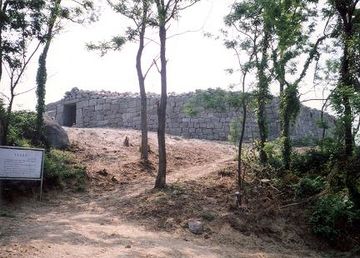"분오리돈대"의 두 판 사이의 차이
(→영문) |
|||
| 31번째 줄: | 31번째 줄: | ||
'''Bunoridondae Outpost''' | '''Bunoridondae Outpost''' | ||
| − | An outpost, called ''dondae'' in Korean, was a small camp set up at a distance from | + | An outpost, called ''dondae'' in Korean, was a small camp set up at a distance from a main military station. It was used to monitor the enemies’ movements and to stand guard against unauthorized intrusions and surprise attacks. |
| − | In 1679, during the Joseon dynasty, Minister of Military Affairs Kim Seok-ju (1634-1684) recommended the construction of outposts in Ganghwado Island to King Sukjong. Yun I-je (1628-1701), | + | In 1679, during the Joseon dynasty, Minister of Military Affairs, Kim Seok-ju (1634-1684), recommended the construction of military outposts in Ganghwado Island to King Sukjong. A local magistrate, Yun I-je (1628-1701), oversaw the construction of 48 outposts. Five additional outposts were added from 1690 to 1696. These outposts were constructed on the coastal upland of Ganghwado, with artillery emplacement surrounded by high stone walls. |
Usually, an outpost belonged to a neighboring fort, but Bunoridondae Outpost was managed by its own commander from the military headquarters of Ganghwa. It has four artillery platforms and 37 battlements. Most of the outposts in this island are rectangular or round in shape, but Bunoridondae shows an interesting crescent shape as it was constructed in accordance with surrounding natural features. The current stone walls were reconstructed in 1994. | Usually, an outpost belonged to a neighboring fort, but Bunoridondae Outpost was managed by its own commander from the military headquarters of Ganghwa. It has four artillery platforms and 37 battlements. Most of the outposts in this island are rectangular or round in shape, but Bunoridondae shows an interesting crescent shape as it was constructed in accordance with surrounding natural features. The current stone walls were reconstructed in 1994. | ||
2018년 7월 17일 (화) 17:31 판
| 분오리돈대 |
|
| 대표명칭 | 분오리돈대 |
|---|---|
| 한자 | 分五里墩臺 |
| 주소 | 인천광역시 강화군 화도면 사기리 산 185-1 |
| 지정번호 | 인천광역시 유형문화재 제36호 |
| 지정일 | 1999.03.29 |
| 분류 | 유적건조물/정치국방/근대정치국방/국방 |
| 시대 | 조선 |
| 수량/면적 | 1기 / 11,728㎡ |
|
|
|
해설문
국문
조선 숙종 5년(1676)[검토 1]에 강화 유수 윤이제가 설치한 여러 돈대 중 하나로 대포 4문을 올려놓은 포좌와 톱니바퀴 모양으로 돌출시킨 치첩(雉堞)이 37개소가 있는 초지진의 외곽 포대이다. 강화도의 돈대가 대부분 사각형이거나 원형인데 반하여 분오리돈대는 자연 지형을 그대로 이용하여 초승달 모양으로 축조하였기에 개성이 도드라진다. 다른 돈대들이 진이나 보에 속했던 것과 달리 이 돈대는 강화 군영에서 돈장(墩將)을 따로 두어 지키게 할 만큼 중요한 돈대였다. 1994년에 복원되었다.
- ↑ 숙종 5년은 1679년임.
영문
Bunoridondae Outpost
An outpost, called dondae in Korean, was a small camp set up at a distance from a main military station. It was used to monitor the enemies’ movements and to stand guard against unauthorized intrusions and surprise attacks.
In 1679, during the Joseon dynasty, Minister of Military Affairs, Kim Seok-ju (1634-1684), recommended the construction of military outposts in Ganghwado Island to King Sukjong. A local magistrate, Yun I-je (1628-1701), oversaw the construction of 48 outposts. Five additional outposts were added from 1690 to 1696. These outposts were constructed on the coastal upland of Ganghwado, with artillery emplacement surrounded by high stone walls.
Usually, an outpost belonged to a neighboring fort, but Bunoridondae Outpost was managed by its own commander from the military headquarters of Ganghwa. It has four artillery platforms and 37 battlements. Most of the outposts in this island are rectangular or round in shape, but Bunoridondae shows an interesting crescent shape as it was constructed in accordance with surrounding natural features. The current stone walls were reconstructed in 1994.
